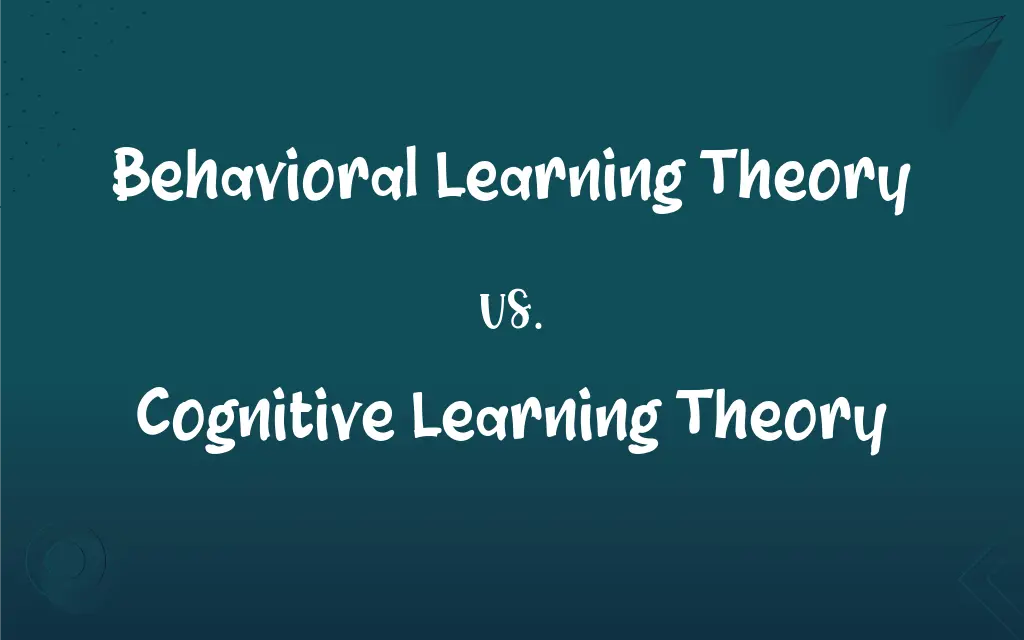Behavioral Learning Theory vs. Cognitive Learning Theory: What's the Difference?
Edited by Aimie Carlson || By Harlon Moss || Published on March 2, 2024
Behavioral learning theory focuses on observable behaviors and external stimuli, while cognitive learning theory emphasizes internal thought processes and understanding.

Key Differences
Behavioral learning theory posits that learning is a result of associations formed between stimuli and responses, emphasizing the role of external factors in shaping behavior. This theory relies on observable outcomes to infer learning, suggesting that behavior changes are a result of experience with the environment. Cognitive learning theory, on the other hand, centers on the mental processes involved in learning. It argues that learning involves understanding, memory, and thinking, and that knowledge acquisition is a result of internal cognitive activity rather than just external stimuli.
Behavioral learning theory utilizes reinforcement and punishment to modify behaviors, suggesting that positive reinforcement encourages behavior repetition, while punishment decreases its occurrence. Cognitive learning theory suggests that learning is more complex, involving active mental construction of knowledge, problem-solving, and understanding. Cognitive theorists believe that learners are not passive recipients of information but actively process and interpret what they learn based on their mental models and previous knowledge.
In the context of education, behavioral learning theory has led to practices such as drill and practice, behavior modification, and the use of rewards to motivate learning. Cognitive learning theory has influenced educational approaches that encourage active engagement, critical thinking, and the development of metacognitive skills. Cognitive strategies include teaching for understanding, encouraging exploration and discovery, and facilitating the connection between new information and existing knowledge.
Behavioral learning theory is often critiqued for its limited focus on observable behavior, neglecting the internal cognitive processes that play a critical role in learning. Cognitive learning theory addresses this gap by considering how thought processes influence learning and behavior. Cognitive theory provides a more holistic view of learning, acknowledging that factors such as beliefs, attitudes, and strategies are crucial for understanding how learning occurs and how knowledge is applied.
Despite their differences, both behavioral and cognitive learning theories have contributed valuable insights into how learning occurs. Behavioral theory offers practical tools for behavior management and the development of learning habits, while cognitive theory enriches our understanding of the complexity of learning processes. The integration of both theories can offer a more comprehensive approach to teaching and learning, recognizing the importance of both external behavior and internal cognitive processes in educational practice.
ADVERTISEMENT
Comparison Chart
Focus
Observable behaviors and external stimuli
Internal thought processes and understanding
Learning Process
Learning through conditioning and reinforcement
Learning through processing, organizing, and interpreting information
Role of the Learner
Passive recipient of stimuli
Active participant in learning process
Key Concepts
Reinforcement, punishment, stimuli-response
Memory, perception, problem-solving
Educational Applications
Behavior modification, rewards and punishments
Critical thinking, metacognition, problem-based learning
ADVERTISEMENT
Behavioral Learning Theory and Cognitive Learning Theory Definitions
Behavioral Learning Theory
Behavioral learning theory emphasizes learning through association between stimuli and responses.
Classical conditioning in behavioral learning theory explains how phobias are developed.
Cognitive Learning Theory
Cognitive learning theory centers on understanding the internal processes of learning.
Cognitive maps in cognitive learning theory explain how people navigate new environments.
Behavioral Learning Theory
It focuses on modifying behavior through reinforcement and punishment.
Using rewards to increase homework completion is an application of behavioral learning theory.
Cognitive Learning Theory
Advocates for active engagement and construction of knowledge by the learner.
Problem-solving activities in classrooms are based on cognitive learning theory.
Behavioral Learning Theory
Advocates for the use of empirical evidence to understand learning processes.
Behavioral learning theory supports the use of controlled experiments to study learning.
Cognitive Learning Theory
Stresses the importance of metacognition in understanding one’s own learning process.
Teaching students to plan, monitor, and evaluate their learning employs cognitive learning theory.
Behavioral Learning Theory
Considers learning as a process of behavioral change observable by external measures.
Behavioral learning theory is applied in training pets through reward-based methods.
Cognitive Learning Theory
It emphasizes the role of mental activities in acquiring and organizing knowledge.
Using concept maps to enhance learning showcases cognitive learning theory in action.
Behavioral Learning Theory
Relies on the environment to shape and control behaviors.
Classroom management techniques often derive from behavioral learning theory.
Cognitive Learning Theory
Focuses on how information is received, processed, stored, and retrieved.
The study of memory strategies is rooted in cognitive learning theory.
FAQs
How do behavioral and cognitive learning theories apply to education?
Behavioral theory informs classroom management and reinforcement strategies, while cognitive theory guides instructional design for deeper understanding and critical thinking.
What is behavioral learning theory?
Behavioral learning theory is a framework that emphasizes learning through interactions with the environment, focusing on observable behaviors and the effects of external stimuli.
Can behavioral and cognitive learning theories be integrated?
Yes, integrating both theories can provide a comprehensive approach to education, addressing both the behavioral and cognitive aspects of learning.
What role does reinforcement play in behavioral learning theory?
In behavioral learning theory, reinforcement is used to increase the likelihood of a behavior being repeated.
How does cognitive learning theory view the learner?
Cognitive learning theory sees the learner as an active participant who constructs knowledge through internal processes.
How does cognitive learning theory address individual differences in learning?
Cognitive learning theory acknowledges individual differences by emphasizing personalized learning paths and strategies.
What is cognitive learning theory?
Cognitive learning theory focuses on the mental processes involved in learning, including understanding, memory, and problem-solving.
What are some criticisms of behavioral learning theory?
Critics argue that behavioral learning theory overlooks the internal cognitive processes essential for understanding complex learning.
What impact has cognitive learning theory had on teaching practices?
Cognitive learning theory has led to practices that promote active engagement, critical thinking, and the development of metacognitive skills.
How does behavioral learning theory address motivation?
Behavioral learning theory uses external rewards and punishments as motivators for learning behaviors.
What is the difference between reinforcement in behavioral theory and feedback in cognitive theory?
Reinforcement in behavioral theory focuses on shaping behavior, while feedback in cognitive theory is used to inform and improve understanding.
What role does memory play in cognitive learning theory?
Memory is crucial in cognitive learning theory, as it involves the processing and storage of information for learning.
What is an example of classical conditioning in behavioral learning theory?
An example is Pavlov's dogs, where dogs learned to associate a bell with food, demonstrating learned behavior.
What is the significance of problem-solving in cognitive learning theory?
Problem-solving is central to cognitive learning theory, highlighting the importance of active engagement in learning.
Can behavioral learning theory be applied to adult education?
Yes, behavioral learning theory can be applied to adult education, particularly in shaping habits and behaviors through reinforcement.
What techniques are derived from behavioral learning theory for behavior modification?
Techniques include positive reinforcement, negative reinforcement, and punishment to modify behavior.
How do both theories inform technology-enhanced learning?
Behavioral theory informs the design of interactive learning environments, while cognitive theory guides the creation of content that stimulates mental processes.
How do behavioral learning theories explain phobias?
Behavioral learning theories explain phobias as learned responses to specific stimuli through conditioning.
How does cognitive learning theory explain concept formation?
Cognitive learning theory explains concept formation as an active process of categorizing information based on characteristics and examples.
How does cognitive learning theory contribute to the development of critical thinking skills?
It encourages the exploration of ideas, questioning assumptions, and applying logic, fostering critical thinking.
About Author
Written by
Harlon MossHarlon is a seasoned quality moderator and accomplished content writer for Difference Wiki. An alumnus of the prestigious University of California, he earned his degree in Computer Science. Leveraging his academic background, Harlon brings a meticulous and informed perspective to his work, ensuring content accuracy and excellence.
Edited by
Aimie CarlsonAimie Carlson, holding a master's degree in English literature, is a fervent English language enthusiast. She lends her writing talents to Difference Wiki, a prominent website that specializes in comparisons, offering readers insightful analyses that both captivate and inform.































































